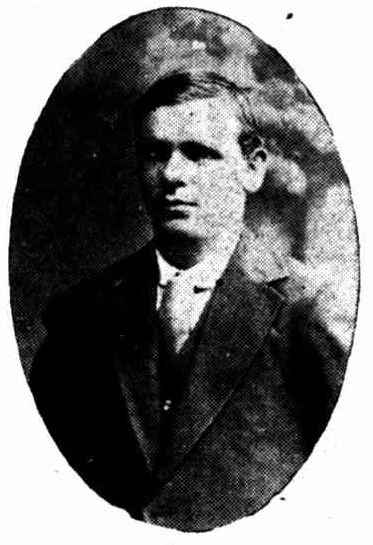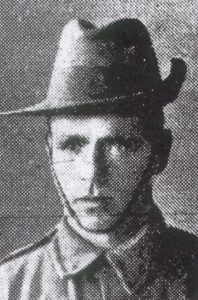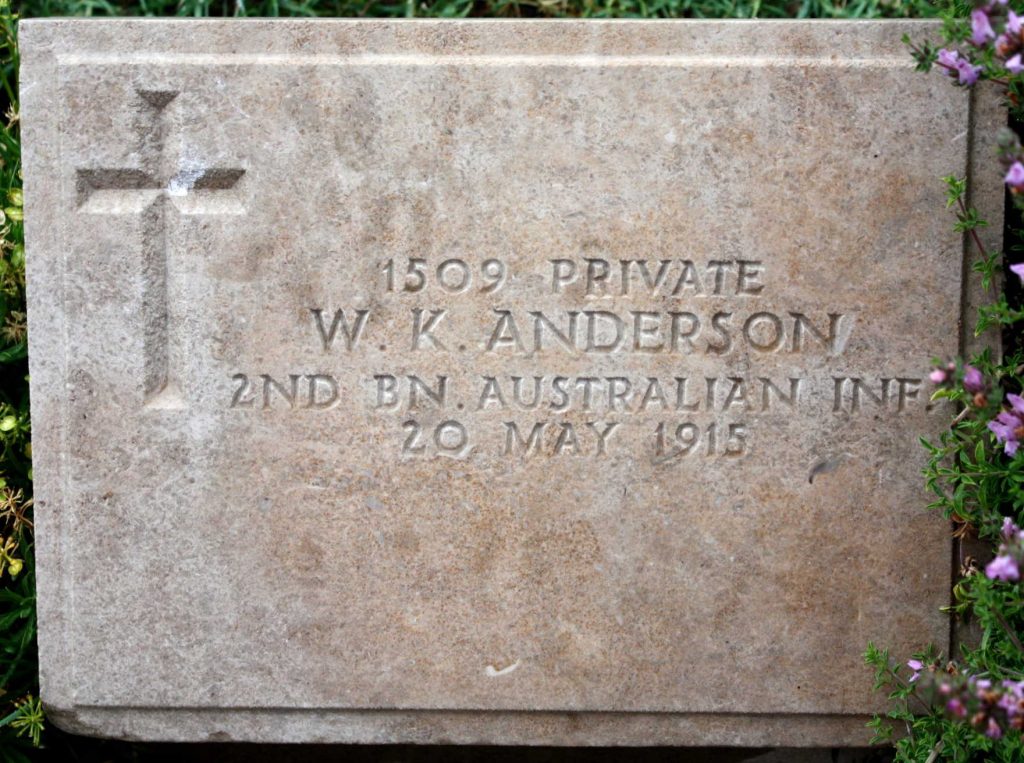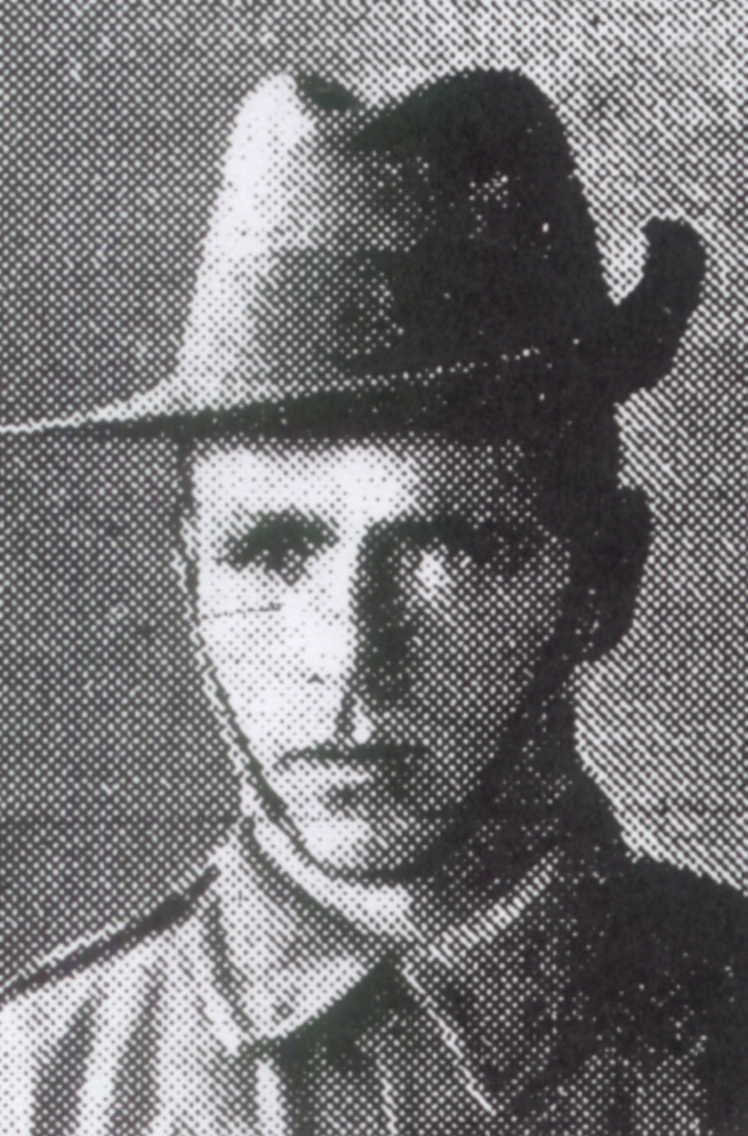Honour roll location: Pillar 4A

Working in Janiember East
William Keith Anderson was a labourer prior to the war, working for Messrs John White and Sons in Janiember East. He was originally from Balranald but had worked on sheep stations in Queensland and Victoria before enlisting. His father was William Anderson senior of the Nunthurungie station on the Darling River in New South Wales. His mother was named Louisa Holly Bowden and he had a brother and three sisters, along with a half-sister from his mother’s previous marriage.
William enlisted on the 31 of October 1914 and went to war at age 24. He embarked on the HMAT Seang Choon in Sydney on the 11th of February 1915.

The first event recorded after William’s embarkation was when he joined the 2nd Battalion at Gallipoli on the 7th of May 1915. Less than two week’s later, he was killed in action.
Heavy bombardment leading up to his death
Very little information can be found detailing the events surrounding William’s death. A glimpse at the unit diary of the 2nd Battalion reveals that on the 18th of May, the Turks had led an attack on the Anzac trenches. The heavy bombardment left large holes in the ground and a thick cloud of smoke and dust as earth was cast around the camp.
“It was the heaviest we have yet seen and lasted over three hours”
2nd Battalion unit diary
In the early hours of the morning on the 19th of May, the Turkish forces made three “determined attempts to take the trenches” but were held back.
By daybreak, the Turks retreated to their trenches and were cut down by the Anzacs machine gunfire. There were hundreds of bodies lying close to William and the trenches he occupied. Reports indicated that they would be heavily reinforced during the day and the Aussies believed another attack was imminent.

During the day of the 19th of May, things quietened down. The unit diary hints at the nervous wait the men had to endure, expecting an attack. At 6pm on the 20th of May, there was an armistice to allow the Turks to retrieve their dead and wounded. The writer of the diary estimated there were 2000 Turkish soldiers dead and another 7000 wounded.
By 7pm, both sides were firing again. With the C and D companies of the 8th Battalion reinforcing them (300 men strong), along with two machine guns, the 2nd Battalion were feeling “absolutely secure”.
We now have 400 men in local reserve and seven machine guns in the firing line of the 2nd Battalion section- about one for every 40 yards of trench.
2nd Battalion unit diary
It may be fair to say that the Australian forces had reason to believe they were relatively safe. Despite the enemy maintaining heavy rifle fire overnight, the 2nd Battalion were able to use their guns and Howitzers to bombard the enemy trenches.
The morning of the 21st of May, the unit diary describes the morning as a “fine day”. Very few casualties had been sustained overnight- only one killed and two missing. We can only presume that one of the two missing men was William.

Despite initially being reported as missing- and even being listed in a police gazette as a deserter, briefly- information was soon received confirming that William had been killed in action. It is likely that his body was found and identified when a truce was called on the 24th of May to bury the dead.
His body was exhumed from its original resting place at Brown’s Dip and re-interred in the Lone Pine Cemetery.

His fate unknown
William’s mother had passed away in 1900 and his father could not be located by William’s brother Alexander. A letter from Alexander to the AIF Base Records department in 1920 states that he had not heard from his father in five years, despite having written to him three times. His father may never have learned of his son’s fate and ultimate sacrifice.
Resources:
- 2nd Australian Infantry Battalion, Australian War Memorial
- 2nd Infantry Battalion, Australian Imperial Force Unit War Diaries: 1914-1918, Australian War Memorial
- Ancestry.com. Australia, Imperial Force Burials At Gallipoli, 1915 [database on-line]. Provo, UT, USA: Ancestry.com Operations, Inc., 2015.
- Anderson, William Keith, Virtual War Memorial of Australia
- ‘Bravest of the brave‘, The Daily Telegraph, 28th June 1915, p. 9
- ‘BRISBANE, QLD. C. 1915. TROOPSHIP SEANG CHOON (A49) SHORTLY AFTER LEAVING PINKENBA WHARF.‘, Australian War Memorial
- ‘Brown’s Dip, showing Artillery Road and Shrapnel Green cemetery‘, Australian War Memorial
- ‘Deserters from HM Service, from AI Force’, Victoria Police Gazette 1915, Ancestry.com. Victoria, Australia, Police Gazettes, 1855, 1864-1924 [database on-line]. Provo, UT, USA: Ancestry.com Operations, Inc., 2016.
- Embarkation roll: William Keith Anderson, Australian War Memorial
- Enlistment records: William Keith Anderson, Discovering Anzacs
- ‘Killed in action‘, The Bendigo Advertiser, 5th July 1915, p. 5
- Nominal roll: William Keith Anderson, Australian War Memorial
- Private William Keith Anderson, Commonwealth War Graves Commission
- ‘Rank and File’, The Daily Telegraph, 25th June 1915, p. 8
- ‘Those who have died for freedom’s cause‘, Bendigonian, 15th July 1915, p. 2
- William Keith Anderson, AIF Project

Leave a Reply
You must be logged in to post a comment.